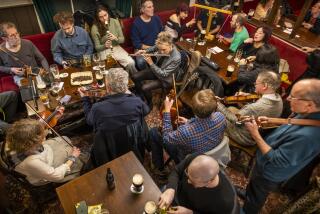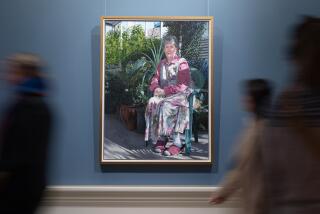Pub-Crawling on the Emerald Isle
- Share via
KINSALE, Ireland — To find “The White House,” “Peyton Place” and “The Cape” among the shamrocks and verdant vistas of Ireland is quite unexpected, but these are the names over the doorways of three classic pubs in Kinsale, Cork City and Wexford.
Although such eye-catching signs often appear on pub facades, a large number of Irish pubs bear more traditional titles or the names of their owners, such as Doheny & Nesbitt in Dublin, Kenny’s at Lahinch, Paddy Burke’s at Clarinbridge and Sloane’s of Tipperary.
The use of family names harks back to the days when the pub was often a country kitchen or a neighborhood home where villagers would gather to sample some of the native brew, usually distilled by the owner of the house.
Over the centuries the Irish pub evolved into a focal point, almost a clubhouse for locals and visitors alike. It also became the ideal place to seal a deal on market day, exchange gossip, argue about politics or finish a long day’s work with a song or a dance.
Many of Ireland’s pubs date back hundreds of years and have been in the same family for generations. Little has changed inside most of them, reflecting nurturing of Irish life style. A few may have added TV, pool tables and dart boards, but the Irish pub is still basically a hybrid of open hearth, meeting room, music hall, news depot and, yes, a congenial setting for some liquid refreshment.
Well-Preserved Specimen
Any tour of the Emerald Isle should include a few pubs if only for a cup of coffee, a friendly chat with the locals or for the history and sightseeing benefits. Who could leave Ireland without setting foot in The Brazen Head, a well-preserved specimen (established in 1198) at the end of a cobblestone lane in Dublin’s Fair City?
This small country (about the size of Maine) has more than 10,000 pubs or public houses, as they are more formally called.
Sometimes you may enter a pub without realizing it. Step into Richard MacDonnell’s tiny establishment in Dingle town and you can buy some groceries for a picnic or a custom-designed leather belt on the left side of the room and then turn to the cozy bar on your right and sip a pint of Guinness.
A favorite with photographers is Con Macken’s in Wexford because of the sign outside that proclaims the dual services offered: “Bar--Undertaker.”
The Office on Sullivan Quay in Cork is a conversation piece for its business-like decor and for the alibi it offers some regular patrons. Irish executive are known to phone home as the evening wears on, using the excuse, “I’m delayed at The Office, dear.”
Sightseeing Attractions
Irish pubs also signal the proximity of many a sightseeing attraction. In Cork City The Grand Circle pub sits in the shadows of the Opera House and the 200-year-old Mutton Lane Inn draws you to one of Cork’s original passageways. If you find The Steeple or The Chimes, you are only a few steps away from ringing the bells of this city’s landmark Shandon Church.
Visitors looking for Limerick’s famous 1691 symbol, the Treaty Stone, will know it is nearby once they see the adjacent Treaty Bar. In Waterford The Reginald is a pub at the entrance to Reginald’s Tower, a 70-foot stone fortress built by the Vikings in 1003 and now a museum. The pub also contains remnants of the old city wall.
In County Wicklow, a pub known as The Meetings is associated with Ireland’s national poet, Thomas Moore. Just beside the pub is “the meeting of the waters,” an idyllic setting at the convergence of the Avonmore and Avonbeg rivers where Moore chose to write some of his most famous verse. Among the Moore memorabilia inside the pub is an 1889 edition of his poems. In neighboring Wexford you can also raise a toast at the Thomas Moore Tavern, birthplace of the poet’s mother.
Other pubs with literary and historic connections include Yeats Tavern in Sligo, the James Joyce in Limerick and the Dublin-based Brian Boru and Henry Grattan.
Meccas for Irish Music
Themes and aspects of Irish country life are also identified with some pubs, such as The Farmer’s Kitchen, Wexford; The Blacksheep, Schull; The Thatch, Killeagh; The Matchmaker, Lisdoonvarna; The Shamrock, Kilkenny; The Ould Plaid Shawl, Kinvara; The Brogue Inn, Tralee, and The Seannachie (Irish Storyteller), Dungarvan.
With names such as The Piper’s Chair and The Harp, it is not surprising that many pubs have also become meccas for Irish music. Head for Gus O’Connor’s at Doolin, O’Shaughnessy’s of Glin or The Abbey Tavern in Dublin, and you’ll hear the foot-tapping sounds of Ireland’s traditional musical instruments, the tin whistle, uilleann pipes, concertina, fiddle and bodhran (a goatskin tambourine-like drum).
The piece de resistance of many pubs such as Ryan’s of Parkgate Street, Dublin, or Hogan’s in Limerick, is the “snug,” a private, closet-size room. Snugs are a throwback to the times before women’s lib when it was not considered proper for females to drink at bars.
In those days, ladies with a thirst were discreetly served through sliding wooden windows connecting the bar counter to the snugs. Today’s imbibers, both male and female, use snugs for tete-a-tete conversations, private meetings or just for fun, gingerly ringing a bell to catch a bartender’s attention.
In recent years, pubs have shown their versatility by introducing inexpensive food service, primarily at lunchtime. Christened “pub grub,” the selection usually includes homemade soups, sandwiches and stews, but is also branching out to lighter cuisine such as creative crudites salads, vegetable quiches and smoked salmon platters.
Fish a Specialty
Fish is the specialty at Aherne’s of Youghal, known for its seafood pies and giant prawn tails. Thanks to the fruit of bountiful Galway Bay, visitors also flock to the 220-year-old thatched pub at Kilcolgan called Moran’s of the Weir. From noon till night, oysters, crab claws and salmon are served, accompanied by Kitty Moran’s freshly baked and irresistible brown bread.
It’s no wonder that before they ever see a shamrock or kiss the Blarney Stone, most visitors to the Emerald Isle usually search for the nearest pub, and the chance to experience the essence of Ireland.
More to Read
Sign up for The Wild
We’ll help you find the best places to hike, bike and run, as well as the perfect silent spots for meditation and yoga.
You may occasionally receive promotional content from the Los Angeles Times.






